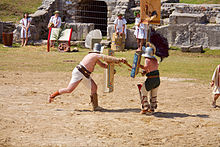Thraex

The Thraex ( lat. " Thracian "; also: Thrax , Threx ) was a heavily armed Roman gladiator .
development
The genus Thraex probably originated in the first half of the first century BC, when numerous Thracian prisoners of war were abducted to Rome during Roman campaigns in the Balkans . In later times, gladiators of the genus thraex could also belong to other races.
In late Republican times and in the first two centuries of our era, the fight between the thraex and the murmillo was by far the most popular gladiatorial duel. After that this argument was also popular, but the combination of retiarius versus secutor came first.
Equipment and armament
The thraex was heavily armed. His weapon was a curved short sword ( sica , falx ). His armor consisted of a Hellenistic / Phrygian helmet, arm protection ( manica ) on the sword arm, a small, rectangular, arched shield ( parma , parmula ), tight-fitting trousers or bandages around the legs and two very high greaves ( ocreae ). He was dressed in a loincloth ( subligaculum ) and a belt ( balteus , cingulum ).
The helmet developed in the pre-republican period. Forms the distinctive comb shape of the Thracian / Phrygian military helmet shape with a protruding crest. The helmet represents a combination of a Hellenistic helmet shape with a Phrygian crest design. All gladiator helmets developed further during the imperial era. The Thraex goes through the development to the Chietityp with full visor, then Pompeii with better visibility and later Berlintyp and Tralles.
opponent
The Thraex's opponent was almost always the Murmillo . In rare cases he also fought against the Hoplomachus and there are currently two pieces of evidence for a fight between Thraex and Thraex, here the Patras relief from Greece should be mentioned.
For other gladiators see: Gladiator types .
literature
- Marcus Junkelmann : Playing with death - This is how Rome's gladiators fought . Zabern, Mainz 2000, ISBN 3-8053-2563-0 ( Antike Welt , special issue; Zabern's illustrated books on archeology ).

